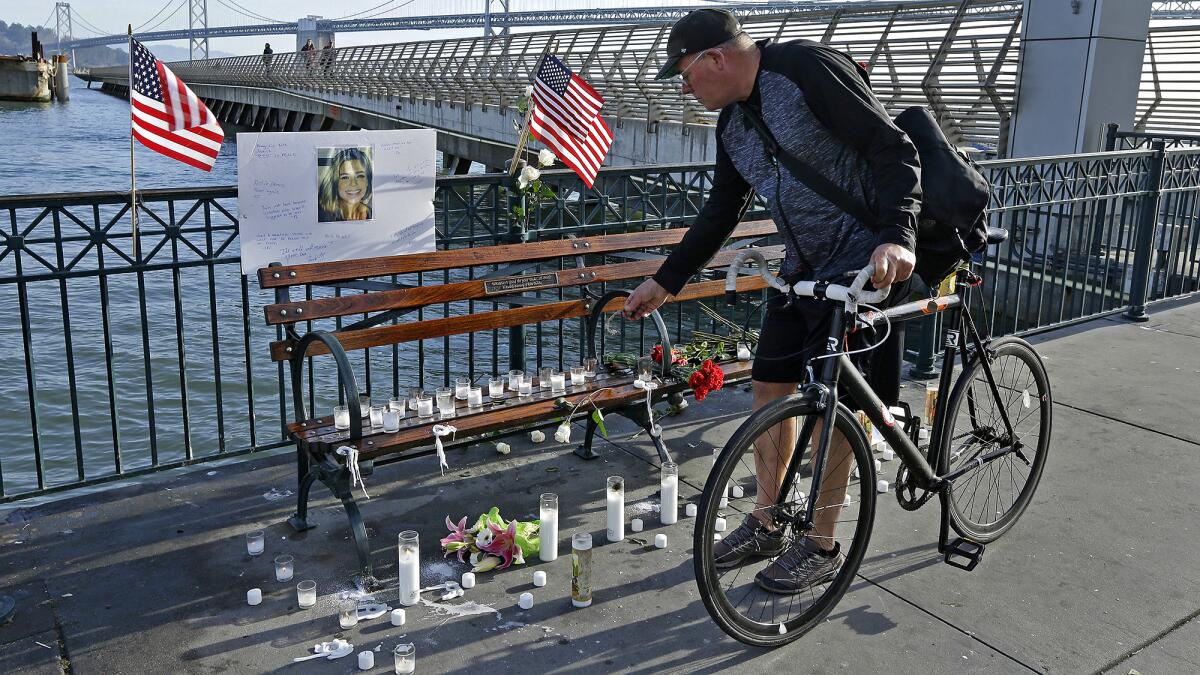The Kathryn Steinle murder trial: Why the jury and Trump saw two different cases

On a breezy summer day two years ago, Kathryn Steinle was strolling with her father along Pier 14 by the Ferry Building in San Francisco, when she was hit by a .40-caliber bullet.
The single shot, fired by a homeless man, had hit the concrete pier first, ricocheting 78 feet before striking her in the back.
Such facts would be parsed in court. But a larger national narrative of the killing split off on a political thread the moment police identified the shooter as Jose Ines Garcia Zarate, an immigrant in the country illegally and a drug offender, whom the city of San Francisco had declined to turn over to federal officials to be deported.
Galvanized by then-presidential candidate Donald Trump, anti-immigration activists blamed the killing on lax border enforcement and so-called sanctuary cities that refused to cooperate with federal authorities — epitomized by the liberal city on the bay.
At the time of the shooting, Trump called Garcia Zarate an “animal,” the embodiment of the “bad hombres” and “rapists” he’d been railing against.
“This senseless and totally preventable act of violence committed by an illegal immigrant is yet another example of why we must secure our border immediately,” Trump said in a statement shortly after Steinle’s death.
But that narrative was not the one the jurors had to assess when they voted to acquit Garcia Zarate, 45, of murder and involuntary manslaughter on Thursday.
Judge Samuel Feng would not allow them to consider the defendant’s immigration status, his five deportations or his multiple drug convictions. They could decide only whether he intentionally shot Steinle on July 1, 2015, or at the least fired the gun with a willful disregard for life.
The jurors, who deliberated for four days, did not explain their unanimous decision to acquit Garcia Zarate of all charges except one count of a being felon in possession of a firearm.
Legal experts said prosecutors had an uphill battle because there was no clear motive in the case. Further muddling the shooter’s intentions: evidence that the bullet hit the ground just 12 feet from the defendant before ricocheting those 78 feet into Steinle.
“On its surface, it seemed like a tough case to prove intent to kill,” said Jim Hammer, former head of the San Francisco district attorney’s homicide unit. “That ricochet, I assume, was a big thing for the jury.”
He said if there are two reasonable explanations on a criminal charge, one pointing toward guilt, one pointing to innocence, California law mandates that jurors must acquit.
Defense attorney Matt Gonzalez argued Garcia Zarate found the stolen pistol wrapped in a rag on the pier and that it accidentally fired when he picked it up.
UC Hastings law professor Hadar Aviram called the verdict a “triumph” for the justice system.
“The jury doesn’t convict people when there’s reasonable doubt,” she said. “That’s what happened here.”
She said prosecutors routinely charge defendants when they know the case will be a tough sell to a jury.
“It’s a natural tendency of everyone,” she said. “When something terrible happens, we look for someone to blame.”
But even critics of San Francisco were surprised the jury did not convict Garcia Zarate of involuntary manslaughter at a minimum, for negligently firing the Sig Sauer pistol on the pier.
Jessica Vaughan, director of policy studies at the Center for Immigration Studies, a Washington, D.C., think tank that advocates for restrictions on immigration, thought the jury was deliberating between second-degree murder and involuntary manslaughter.
“I was very shocked that they bought into this idea that this was some accident that he shouldn’t be held responsible for,” Vaughan said. “I was very surprised and saddened for the Steinle family with this very controversial and unsatisfying verdict.”
The Steinle family told the San Francisco Chronicle they were “saddened and shocked by the verdict.”
“Justice was rendered, but it was not served,” said Jim Steinle, whose daughter died in his arms.
While Steinle told the newspaper he was not totally opposed to the sanctuary city concept, he did blame a cascade of bad decisions by the federal and local governments for Garcia Zarate being on the streets that day.
The Mexican immigrant had been in federal custody for reentering the country illegally and handed over to the San Francisco sheriff to be prosecuted for a 20-year-old marijuana case.
Sheriff Ross Mirkarimi’s decision to release Garcia Zarate — 10 weeks before the killing — without notifying federal authorities helped lead to his reelection loss in 2016.
In the political arena, that decision was on trial as much as Garcia Zarate’s motivations on the pier.
“San Francisco’s decision to protect criminal aliens led to the preventable and heartbreaking death of Kate Steinle,” U.S. Atty. Gen. Jeff Sessions said in a statement Thursday. “I urge the leaders of the nation’s communities to reflect on the outcome of this case and consider carefully the harm they are doing to their citizens by refusing to cooperate with federal law enforcement officers.”
President Trump criticized the verdict in multiple tweets.
“The Kate Steinle killer came back and back over the weakly protected Obama border, always committing crimes and being violent, and yet this info was not used in court,” he wrote. “His exoneration is a complete travesty of justice. BUILD THE WALL!”
Latino and immigrant activists fear the decision could lead to further backlash against them, led by the president.
“It’s very equivalent to when there is a terrorist attack – that many communities of color are hoping and praying it’s not going to be a person of color,” said Angelica Salas, executive director of the Coalition for Humane Immigrant Rights of Los Angeles, “because it’s not just about that individual and that individual having mental issues or just the particulars of that individual, but that individual’s actions then actually paint the entire community.”
She said she was heartened that the 12 jurors used “common sense” to see through the politics.
But on a broader scale, Salas said, the case “was used as a means by which to denigrate all immigrants, by which to create this really almost mob like mentality against immigrants and paint them all as criminal and the worst of the worst.”
[email protected] | Twitter @joemozingo
[email protected] | Twitter: @brittny_mejia
More to Read
Sign up for Essential California
The most important California stories and recommendations in your inbox every morning.
You may occasionally receive promotional content from the Los Angeles Times.












